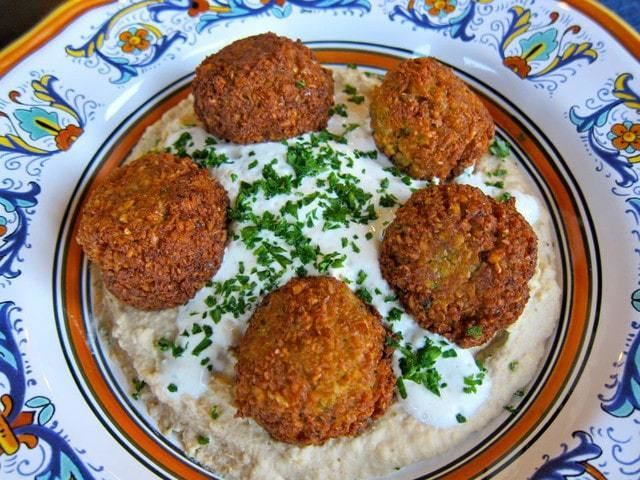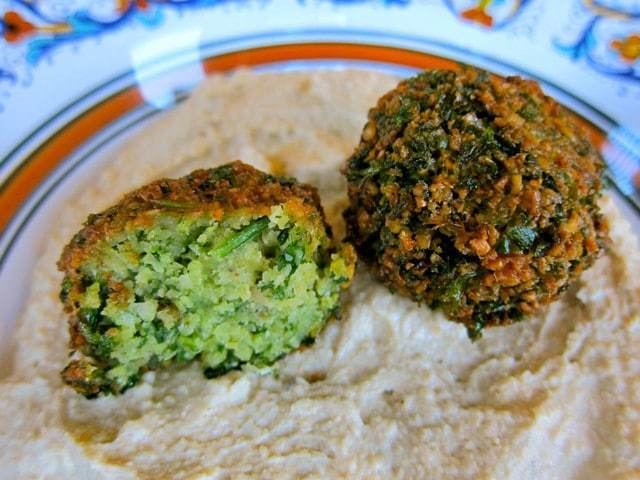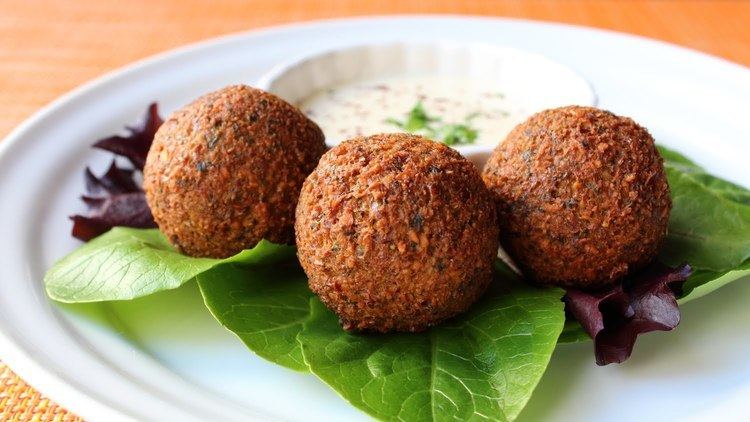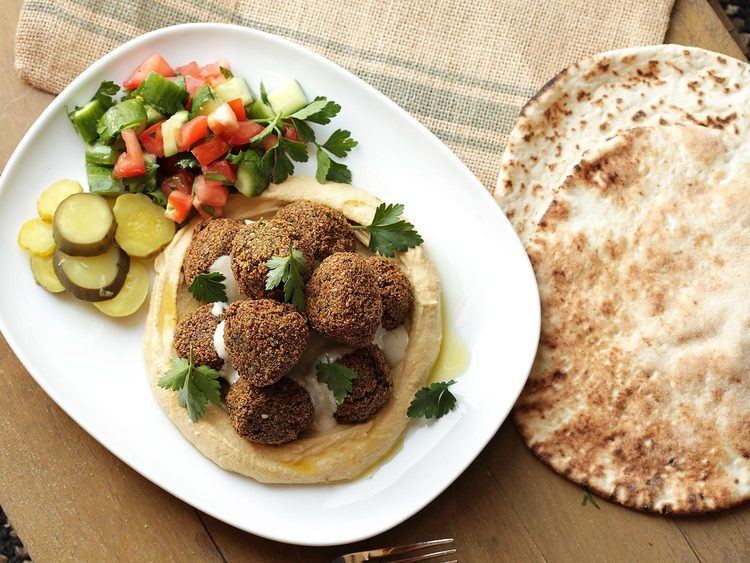Alternative names Felafel | Course Meze Serving temperature Hot | |
 | ||
Similar Hummus, Chickpea, Shawarma, Pita, Tahini | ||
How to make falafel crispy fried garbanzo bean chickpea fritter recipe
Falafel (/fəˈlɑːfəl/; Arabic: فلافل, [fæˈlæːfɪl], dialectal: [fæˈlæːfel]) is a deep-fried ball or patty made from ground chickpeas, fava beans, or both. Falafel is a traditional Middle Eastern food, commonly served in a pita, which acts as a pocket, or wrapped in a flatbread known as taboon; "falafel" also frequently refers to a wrapped sandwich that is prepared in this way. The falafel balls are topped with salads, pickled vegetables, hot sauce, and drizzled with tahini-based sauces. Falafel balls may also be eaten alone as a snack or served as part of a meze (assortment of appetizers).
Contents
- How to make falafel crispy fried garbanzo bean chickpea fritter recipe
- Lebanese falafel wrap easy to make wrap recipe ruchi unboxes with bajaj electricals
- Etymology
- History
- Middle East
- North America
- Germany
- Vegetarianism
- Preparation and variations
- Nutrition
- Largest falafel ball
- Largest serving of falafel
- References

Falafel is a common food eaten throughout the Middle East. The fritters are now found around the world as a replacement for meat and a form of street food.

Lebanese falafel wrap easy to make wrap recipe ruchi unboxes with bajaj electricals
Etymology

The word Falāfil (Arabic: فلافل) is the plural of Filfil (فلفل), meaning "pepper". The word itself spread and is used in other languages such as Persian pilpil (پلپل), from the Sanskrit word pippalī (पिप्पली), meaning "long pepper"; or an earlier *filfal, from Aramaic pilpāl, "small round thing, peppercorn," derived from palpēl, "to be round, roll". Thus in origin, falafel would be "rollers, little balls."

A Coptic Egyptian origin has recently been proposed via the unattested phrase *pha la phel (Φα Λα Φελ), meaning "of many beans".

The Arabic word falāfil has been globalized into many other languages and spread around the rest of the world as the general name for this food. In English, it is first attested in 1941.

Falafel is known as taʿamiya (Egyptian Arabic: طعمية ṭaʿmiyya, IPA: [tˤɑʕˈmejjɑ]) in Egypt. The word is derived from a diminutive form of the Arabic word ṭaʿām (طعام, "food"); the particular form indicates "a unit" of the given root in this case Ṭ-ʕ-M (ط ع م, having to do with taste and food), thus meaning "a little piece of food" or "small tasty thing".
The word falafel can refer to the fritters themselves or to sandwiches filled with them.
History
The origin of falafel is unknown and controversial. A common theory is that the dish originated in Egypt, possibly eaten by Copts as a replacement for meat during Lent. As Alexandria is a port city, it was possible to export the dish and name to other areas in the Middle East. The dish later migrated northwards to the Levant, where chickpeas replaced the fava beans. It has been speculated that its history may go back to Pharaonic Egypt.
Middle East
Falafel grew to become a common form of street food or fast food in Egypt and the Middle East. The croquettes are regularly eaten as part of meze. During Ramadan, falafel balls are sometimes eaten as part of the iftar, the meal that breaks the daily fast after sunset. Falafel became so popular that McDonald's for a time served a "McFalafel" in its breakfast menu all over Egypt. Falafel is still popular with the Copts, who cook large volumes during religious holidays. Debates over the origin of falafel have sometimes devolved into political discussions about the relationship between Arabs and Israelis. In modern times, falafel has been considered a national dish of Egypt, Palestine, and of Israel. Resentment exists amongst many Palestinians for what they see as the appropriation of their dish by Israelis. Additionally, the Lebanese Industrialists' Association has raised assertions of copyright infringement against Israel concerning falafel.
Falafel plays an iconic role in Israeli cuisine and is widely considered to be the national dish of the country. While falafel is not a specifically Jewish dish, it was eaten by Mizrahi Jews in their countries of origin. Later, it was adopted by early Jewish immigrants to Palestine. Due to its being entirely plant based, it is considered pareve under Jewish dietary laws and gained acceptance with Jews because it could be eaten with meat or dairy meals. According to Jonathan Kis-Lev, falafel and hummus are often used as symbols for peace, as well as tools for bridging Israelis and Palestinians.
In 2012, one of the hotels in the capital of Jordan, Amman, prepared the world's largest Falafel disc weighing about 75 kg – breaking the previous record set at a Jewish food festival in the United States.
North America
In North America, prior to the 1970s, falafel was found only in Middle Eastern and Jewish neighborhoods and restaurants. Today, the dish is a common and popular street food in many cities throughout North America.
Germany
Germany saw an increase of falafel in the last years. (Western) Berlin has a special role, as it hosts a comparably large Arab community due to historical reasons. Different as in the case of döner kebab, falafel stands are less frequently found in neighborhoods with higher Arab immigrant population but have been installed in neighborhoods undergoing gentrification. While the operators are often Arab men with an academic or artistic background, the customers are predominantly middle-class Germans. Most falafel stands themselves provide imagined scenery of the Arab world, that differs positively from generic prejudices. Falafel stalls in Berlin signify ongoing gentrification processes. The Wrangelquartier in Berlin, a part of Kreuzberg, has been dubbed Falafelkiez. The attempt to install a McDonald franchise in the left-leaning neighborhood led to a public uproar, while falafel stands never raised any controversy.
Typical of German preparations is the use of a sweet mango sauce instead of the slightly salty relishes used in Arab countries. In addition, falafel in Berlin is usually served as take-away food, combined with vegetables and different sauces in a pita or döner bread. Restaurants associated with the thriving Jewish and Israeli community in Berlin, including the Kanaan in Prenzlauer Berg (which is based on an Israeli-Palestinian cooperation) tend to serve complete Falafel meals, not carry-out.
Vegetarianism
Falafel has become popular among vegetarians and vegans, as an alternative to meat-based street foods, and is now sold in packaged mixes in health-food stores. While traditionally thought of as being used to make veggie burgers, its use has expanded as more and more people have adopted it as a source of protein. In the United States, falafel's versatility has allowed for the reformulating of recipes for meatloaf, sloppy joes and spaghetti and meatballs into vegetarian dishes.
Preparation and variations
Falafel is made from fava beans or chickpeas, or a combination of the two. The use of chickpeas is predominant in most Middle Eastern countries. The dish is usually made with chickpeas in Syria, Lebanon, Jordan, Israel and Palestine. This version is the most popular in the West. The Egyptian variety uses only fava beans.
When chickpeas are used, they are not cooked prior to use (cooking the chickpeas will cause the falafel to fall apart, requiring adding some flour to use as a binder). Instead they are soaked (sometimes with baking soda) overnight, then ground together with various ingredients such as parsley, scallions, and garlic. Spices such as cumin and coriander are often added to the beans for added flavor. The dried fava beans are soaked in water and then stone ground with leek, parsley, green coriander, cumin and dry coriander. The mixture is shaped into balls or patties. This can be done by hand or with a tool called an aleb falafel (falafel mould). The mixture is usually deep fried, or it can be oven baked.
When not served alone, falafel is often served with flat or unleavened bread when it is wrapped within lafa or stuffed in a hollow pita. Tomatoes, lettuce, cucumbers, and other garnishes can be added. Falafel is commonly accompanied by tahini.
Falafel is typically ball-shaped, but is sometimes made in other shapes, particularly donut-shaped. The inside of falafel may be green (from green herbs such as parsley or green onion), or tan.
Nutrition
When made with chickpeas, falafel is high in protein, complex carbohydrates, and fiber. Key nutrients are calcium, iron, magnesium, phosphorus, potassium, zinc, copper, manganese, vitamin C, thiamine, pantothenic acid, vitamin B, and folate. Phytochemicals include beta-carotene. Falafel is high in soluble fiber, which has been shown to be effective in lowering blood cholesterol.
Chickpeas are low in fat and contain no cholesterol, but a considerable amount of fat is absorbed during the frying process. Falafel can be baked to reduce the high fat content associated with frying.
Largest falafel ball
The current record, 74.75 kg (164.4 lb), was set on 28 July 2012 in Amman, Jordan. The previous record was 23.94 kg (52.8 lb), 1.17 m in circumference and 0.3 m in height, set at the Santa Clarita Valley Jewish Food and Cultural Festival (US), at the College of the Canyons in Valencia, California, US, on 15 May 2011.
Largest serving of falafel
The record, 5,173 kg (11,404 lb 8 oz), was set by Chef Ramzi Choueiri and the students of Al-Kafaat University (Lebanon) in Beirut on 9 May 2010.
